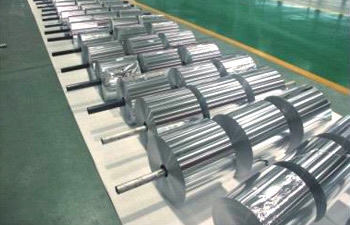
[China Aluminum Industry Network] The paste of composite aluminum foil is carried out on an applicator with an aluminum foil and a reel of paper (or plastic film) and a take-up shaft of a composite aluminum foil, a tray containing adhesive, and an adhesive bond. The roller system of the agent also includes a guide roller, a flattening roller, a pressing roller, a heating roller, a cooling roller, and a temperature and tension adjusting device.
There are three kinds of methods for sticking composite aluminum foil: wet method, dry method, and thermosetting method.
Wet bonding
Wet bonding is a method using a water solvent or a water-dispersible binder to stick an aluminum foil and a composite layer together in a wet state, and then drying to evaporate water. Therefore, the composite layer is required to have a certain permeability and porosity. .
Wet bonding is commonly used for crepe paper. The binders should be soluble in water or diluted with water. They can be protein-based binders such as glue, animal glue, and casein, or carbohydrate-based binders such as starch, dextrin, and cellulose. ; can also be water glass, acrylic, modified vinyl acetate and ethylene-vinyl acetate copolymer and other organic or inorganic binder. The binder is usually neutral, but it can also be slightly alkaline, slightly corrosive to the aluminum foil and securely adhered.
The most used binders are water glass (sodium silicate, foaming alkali) and vinyl acetate. Water glass is cheap, but it becomes brittle after drying and turns yellow after long-term resetting. Vinyl acetate is strong, soft, and water-resistant, but its price is higher.
Dry bonding
Dry bonding is used for the bonding of airtight plastic films. Binder is divided into three types: vinyl acetate, vinyl chloride and other solvent type; nitrocellulose, acetaldehyde cellulose, formaldehyde, cellulose and other fiber types; synthetic rubber and propylene resin copolymers and other types.
Dry Bonding The binder is first dissolved in a volatile solvent such as acetone and ethanol, coated on aluminum foil, dried, and pressed together with the film with a certain pressure. Considering that the drying temperature (about 240-250°C) exceeds the temperature tolerance of the plastic film and the physicochemical effect of the solvent on the plastic film, the adhesive is usually coated on the aluminum foil. In order to improve the fastness of the paste, the plastic film must be corona treated before it is applied.
In wet and dry methods, the adhesive's type, concentration, viscosity, solid content (kg/m3), operating temperature, and coating amount all affect the fastness and speed of application. It should be based on the material of the composite layer. Characteristics to determine.
Thermosetting Bonding
Hot-stamped adhesive bonding wax coating and polyethylene bonding two.
Wax sticking is the use of molten paraffin as a sticking agent to apply paper to aluminum foil. According to the melting temperature of wax during processing, it can be divided into low melting point (66-99°C), middle melting point (100-149°C) and high melting point (150-230°C). In order to prevent surface agglomeration, about 5% of polyethylene can be added to the paraffin. The use temperature is 8°C higher than its cloud point. Paraffin foil aluminum foil has good elasticity and flexibility, can be used to package delicate food such as candy, snacks, butter, bread, etc. It can also pack small metal products, instruments, instruments and photographic equipment.
When coated with polyethylene, because the melting point of polyethylene is higher than that of wax, roller coating can no longer be used. Extrusion coating is used: the pelletized polyethylene is continuously fed into a screw extruder and softened by heating. Extruded from the gap in the mold, coated between paper and aluminum foil, and stuck them together. Polyethylene is divided into low density, medium and high grades by 3 gears. Adhesion is suitable for low-density polyethylene, the melting temperature is 260 - 280 °C, the preheating temperature is 310 °C, and the paste part temperature is 205 °C, the paste temperature should be controlled. Paste fastness is related to the coating thickness, generally 0.01 to 0.07mm, and the paste fastness is thick. In addition, this method preferably uses a degreasing soft aluminum foil. Due to the high paste temperature, it is also possible to paste directly with hard aluminum foil without oil removal. At this time, the temperature and speed should be controlled. In addition to ensuring a firm paste, the productivity should be higher.
ZHEJIANG HESHUO TECHNOLOGY CO.,LTD , https://www.hosuocn.com